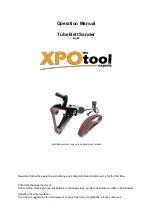
5
While pulling abrasive paper to maintain the proper
tension, insert and secure the other end of abrasive
paper between another clamper and the pad and return
the clamp lever to the original position.
To remove the paper, release the clamper as stated
above.
For conventional type of abrasive paper without
pre-punched holes (available on the market):
Fig.4
Press down the clamp lever 1 and with the clamp lever
pressed down slide it toward the tool 2 and the clamper
will be released.
Insert the paper end between a clamper and the pad
aligning the paper edges even and parallel with the
sides of the base. Then return the clamp lever to the
original position to secure it.
Release the other clamp lever by repeating the same
procedure.
While pulling abrasive paper to maintain the proper
tension, insert and secure the other end of abrasive
paper between another clamper and the pad and return
the paper clamp lever to the original position.
Place the punch plate (optional accessory) over the
paper so that the guide of the punch plate is flush with
the sides of the base. Then press the punch plate to
make holes in the paper.
To remove the paper, release the clamper as stated
above.
For hook-and-loop type of abrasive paper with pre-
punched holes (optional accessory):
CAUTION:
•
Always use hook-and-loop type of abrasive papers.
Never use pressure-sensitive abrasive paper.
Fig.5
Remove the pad for the conventional type of abrasive
paper from the tool with a screwdriver. Install the pad for
the hook-and-loop type of abrasive paper (optional
accessory) on the tool. Tighten the screws firmly to
secure the pad.
Fig.6
Remove all dirt or foreign matter from the pad. Attach
the paper to the pad, aligning the holes in the paper with
those in the pad.
Fig.7
CAUTION:
•
When removing the pad, O ring may come out of
the tool. When this occurs, return the O ring to the
original position and then install the pad.
Dust bag (optional accessory)
Fig.8
Attach the dust bag onto the dust spout. The dust spout
is tapered. When attaching the dust bag, push it onto
the dust spout firmly as far as it will go to prevent it from
coming off during operation.
For the best results, empty the dust bag when it
becomes approximately half full, tapping it lightly to
remove as much dust as possible.
Installing filter (Optional accessory)
Fig.9
Make sure that the logo on the cardboard lip and the
logo on the dust box are on the same side, then install
the filter by fitting the cardboard lip in the groove of each
holding tab.
Fig.10
Make sure that the logo on the cardboard lip and the
logo on the dust nozzle are on the same side, then
install the dust nozzle on the dust box. Removing dust
box and filter.
Fig.11
Remove the dust nozzle by pushing the two latches.
Fig.12
Remove the filter first by pinching the logo side of its
cardboard lip, then by pulling the cardboard lip
downwards to move it out of the holding tab of the dust
box.
OPERATION
Sanding operation
Fig.13
CAUTION:
•
Never run the tool without the abrasive paper. You
may seriously damage the pad.
•
Never force the tool. Excessive pressure may
decrease the sanding efficiency, damage the
abrasive paper or shorten tool life.
Hold the tool firmly. Turn the tool on and wait until it
attains full speed. Then gently place the tool on the
workpiece surface. Keep the pad flush with the
workpiece and apply slight pressure on the tool.
MAINTENANCE
CAUTION:
•
Always be sure that the tool is switched off and
unplugged before attempting to perform inspection
or maintenance.
NOTICE:
•
Never use gasoline, benzine, thinner, alcohol or
the like. Discoloration, deformation or cracks may
result.
To maintain product SAFETY and RELIABILITY, repairs,
carbon brush inspection and replacement, any other
maintenance or adjustment should be performed by
Makita Authorized Service Centers, always using Makita
replacement parts.






































